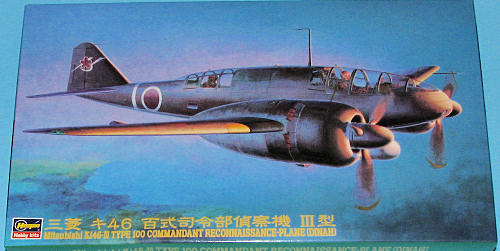
Hasegawa 1/72 Ki-46-III
| KIT #: | 51206 |
| PRICE: | $15.95 from www.greatmodels.com |
| DECALS: | Three options |
| REVIEWER: | Scott Van Aken |
| NOTES: | 2000 boxing |

| HISTORY |
On 12 December 1937, the Imperial Japanese Army Air Force issued a specification to Mitsubishi for a long-range strategic reconnaissance aircraft to replace the Mitsubishi Ki-15. The specification demanded an endurance of six hours and sufficient speed to evade interception by any fighter in existence or development, but otherwise did not constrain the design.
The resulting design was a twin-engined, low-winged monoplane with a retractable tailwheel undercarriage. It had a small diameter oval fuselage which accommodated a crew of two, with pilot and observer situated in individual cockpits separated by a large fuel tank. Further fuel tanks were situated in the thin wings both inboard and outboard of the engines, giving a total fuel capacity of 1,490 L (328 imperial gallons). The engines, two Mitsubishi Ha-26, were housed in close fitting cowlings developed by the Aeronautical Research Institute of the Tokyo Imperial University to reduce drag and improve pilot view.
The first prototype aircraft, with the designation Ki-46, flew in November 1939 from the Mitsubishi factory at Kakamigahara, Gifu, north of Nagoya. Tests showed that the Ki-46 was underpowered, and slower than required, only reaching 540 km/h (336 mph) rather than the specified 600 km/h (373 mph). Otherwise, the aircraft tests were successful. As the type was still faster than the Army's latest fighter, the Nakajima Ki-43, as well as the Navy's new A6M2, an initial production batch was ordered as the Army Type 100 Command Reconnaissance Plane Model 1 (Ki-41-I).
To solve the performance problems, Mitsubishi fitted Ha-102 engines, which were Ha-26s fitted with a two stage supercharger, while increasing fuel capacity and reducing empty weight to give the Ki-46-II, flying in March 1941. This met the speed requirements of the original specification, and was ordered into full-scale production, with deliveries starting in July.
Although at first the Ki-46 proved almost immune from interception, the Imperial Japanese Army Air Force realised that improved Allied fighters such as the Supermarine Spitfire and P-38 Lightning could challenge this superiority, and in July 1942, it instructed Mitsubishi to produce a further improved version, the Ki-46-III. This had more powerful, fuel-injected Mitsubishi Ha-112 engines, and a redesigned nose, with a fuel tank ahead of the pilot and a new canopy, smoothly faired from the extreme nose of the aircraft, eliminating the "step" of the earlier versions. The single defensive machine gun of the earlier aircraft was also omitted. The new version first flew in December 1942, demonstrating significantly higher speed (630 km/h (391 mph) at 6,000 m (19,700 ft). The performance of the Ki-46-III, proved superior to that of the aircraft intended to replace it (the Tachikawa Ki-70), which did not enter production.
In an attempt to yet further improve the altiude performance of the Ki-46, two prototypes were fitted with exhaust driven turbosupercharged Ha-112-II-Ru engines, flying in February 1944, but only two prototypes of this version were built.
Mitsubishi factories made a total of 1,742 examples of all versions (34 units Ki-46-I, 1093 units Ki-46-II, 613 units Ki-46-III, 4 units Ki-46-IV)during 1941-44.
| THE KIT |
 While
this is not a new kit, it is one that has not yet been previewed and is one of a
series of Japanese twin engine aircraft that Hasegawa released at the turn of
the century. In common with those kits, this one has fine engraved panel lines,
fairly good interior detailing and uses decals for the instrument panels.
While
this is not a new kit, it is one that has not yet been previewed and is one of a
series of Japanese twin engine aircraft that Hasegawa released at the turn of
the century. In common with those kits, this one has fine engraved panel lines,
fairly good interior detailing and uses decals for the instrument panels.
The interior
has a long floor piece with the pilot's seat and control stick in the front
followed by a fuel tank, camera, camera operator's seat and a rear bulkhead. As
there were several versions of the Ki-46, Hasegawa has molded the nose sections
separate to take these into consideration. There is a nicely done engine
assembly and one piece cowlings. A large greenhouse covers the crew area with a
blended canopy in the front and a larger aft section. There is only one real
option and that is a large drop ta nk,
which in my opinion, does nothing for the looks of the aircraft. Unlike some
other companies, the holes for this are not pre-drilled so it can be left off
without any problems.
nk,
which in my opinion, does nothing for the looks of the aircraft. Unlike some
other companies, the holes for this are not pre-drilled so it can be left off
without any problems.
Instructions are typical for Hasegawa with well drawn construction sequences and Gunze paint references. Markings are supplied for three aircraft. First is a 15th Flight Regiment plane as shown on the box art It is painted a brownish upper surface color that you will have to mix with a green-grey underside. Similarly colored is a 6th Air Wing Headquarters Reconnaissance Squadron plane, while the third is Army Green on the upper surface and this one is from the 19th Company Independent Flight. All have yellow wing leading edge ID bands which are supplied on the sheet.
| CONCLUSIONS |
In all, it is a very nice kit of an important WWII Japanese type. It is also not one that will be fiddly to build and as such should go together quickly.
| REFERENCES |
http://en.wikipedia.org/wiki/Mitsubishi_Ki-46
May 2010
You can find this and many other fine kits and accessories at GreatModels
If you would like your product reviewed fairly and quickly, please contact me or see other details in the Note to Contributors.